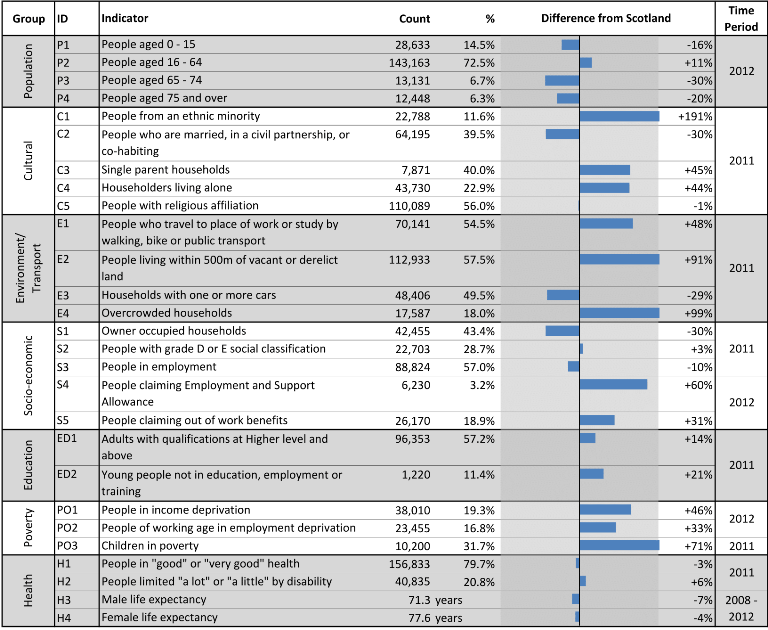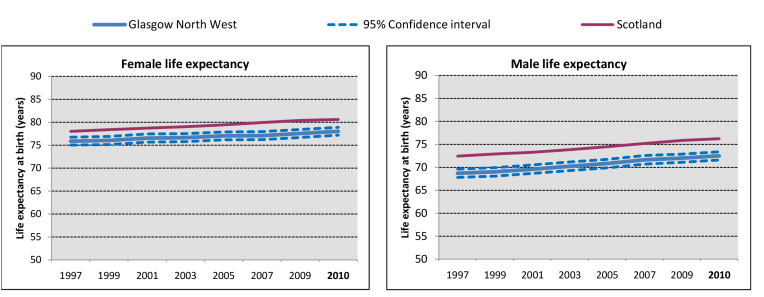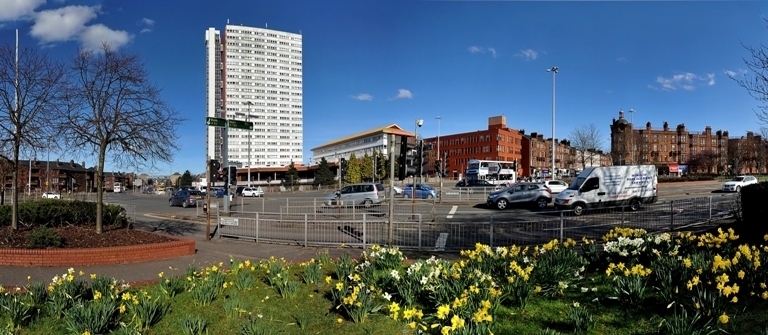North West Sector
North West Sector
Kelvindale and Kelvinside
Maryhill Road Corridor
North Maryhill and Summerston
Ruchill and Possilpark
Lambhill and Milton
City Centre and Merchant City
Yorkhill and Anderston
Hillhead and Woodlands
Hyndland, Dowanhill and Partick East
Broomhill and Partick West
Anniesland, Jordanhill and Whiteinch
Yoker and Scotstoun
Knightswood
Blairdardie
Drumchapel
Temple and Anniesland
*Please note that this profile is based on data from the 2011 Census.*
A printer friendly version of this sector profile can be downloaded here
The Glasgow North West sector has a population of 197,375.
Sector comparisons with Scotland
Male and female life expectancy is close to the Glasgow average and slightly lower than the Scottish average. Women live, on average, five-and-a-half years longer than men. Nearly 12% of the population is from an ethnic minority. Single-parent households make up 40% of all households with dependent children. Fifty-five per cent of the population travel to work (or study) by public transport, on foot or by bike. Nineteen per cent of adults are claiming out of work benefits. Thirty-two per cent of children live in poverty and levels of deprivation are higher than the Scottish average. Twenty-one per cent of people have a limiting disability.
 Sector trends
Sector trends
 Life expectancy for both males and females has risen in recent years in Glasgow North West but remains below the Scottish average. In the most recent period shown (2008-12), life expectancy was 72.5 years for men and 78.0 years for women, notably lower than the Scottish average, particularly for men.
Life expectancy for both males and females has risen in recent years in Glasgow North West but remains below the Scottish average. In the most recent period shown (2008-12), life expectancy was 72.5 years for men and 78.0 years for women, notably lower than the Scottish average, particularly for men.
 The population in Glasgow North West decreased by 1.2% between 1996 and 2012, reflecting decreases in the numbers of children and older people. The percentage of the total sector population from a minority ethnic group rose from 5% in 2001 to 12% in 2011. The percentage of population from an ethnic minority has remained close to the Glasgow average between 2001 and 2011, and is above the national average.
The population in Glasgow North West decreased by 1.2% between 1996 and 2012, reflecting decreases in the numbers of children and older people. The percentage of the total sector population from a minority ethnic group rose from 5% in 2001 to 12% in 2011. The percentage of population from an ethnic minority has remained close to the Glasgow average between 2001 and 2011, and is above the national average.
Notes
A document giving detailed notes and definitions for the information presented in this profile can be downloaded here.
An Excel workbook containing the data used in all of the profiles can be downloaded here. This workbook also includes alternative output formats and further breakdowns of some of the variables.
1. Data sources: Scottish Index of Multiple Deprivation (SIMD) 2012, Census 2011, Census 2001, HMRC, NOMIS, National Records of Scotland (NRS) and Scottish Government.
2. Populations presented in the population trend chart and used to calculate life expectancy estimates are taken from NRS small area population estimates and are based on: the 2001 Census for the years 1996-2001; both the 2001 and 2011 Census for the years 2002-2010; and the 2011 Census for the years 2011-2012.
3. The Income deprivation and Employment deprivation indicators are derived from SIMD 2012, more information on this deprivation index can be found at: http://simd.scotland.gov.uk/publication-2012
4. Life expectancies are calculated based on population estimates and death registrations. 95% confidence intervals have been added on the graphs to give an indication of their accuracy. The x-axes of the life expectancy graphs give the mid-year for each life expectancy estimate, e.g. 2010 represents the life expectancy estimate for the period 2008-2012.
Glasgow City Council have also produced neighbourhood profiles based on data from the 2011 Census which can be accessed via this link.
